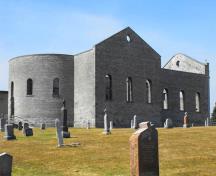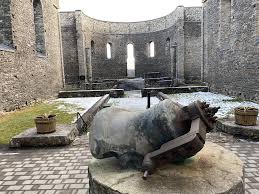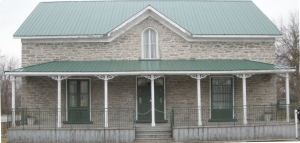Martintown, the Ruins at St Raphael, St Andrews West
- gailgauvreau
- Sep 5, 2020
- 7 min read
Updated: Apr 6, 2021
About a sixty-minute drive south of Canada’s Capital, on County Road 18, lies the little village of Martintown. Around 98km from Ottawa, 110km from Montreal and 180km from Kingston, you will find a village steeped in history and full of family memories for me. Although I never lived here, both my paternal great grandmother and my grandfather did and so my childhood memories are filled with trips to the family farm, the village, and the places nearby.
If I were to exit the laneway of my grandfather’s farm and turn left to walk along County Road 18 into the village, I would always pass a sign that announced I was entering Martintown with a population of 104. My cousins, who lived on the farm next to my grandfather’s place, used to joke that they changed the population number with every birth or death.
Martintown was originally the home of the Longue Point tribe who reportedly lived in the area until driven out by the warriors of the Five Nations. Often referred to as the Iroquois nation, the Five Nation tribes consisted of the Mohawks, Oneidas, Senecas, Cayugas and Onondagas. History books state that they had, through necessity, become fierce warriors who helped the English win the battle for North America over the French.
The first European settlers arrived in the area around the 1780s but it is well known that coureur des bois had been working in the region for over a century and priests from France had also lived in the region in efforts to convert the inhabitants. United Empire Loyalists consisting of the officers and families of the First Battalion King’s Royal Regiment of New York and Vermont, settled in the area after the American Revolution and with a gift of land and a cow, their loyalty to the crown was repaid. A contingent of the 84th Royal Highland Emigrants also arrived around the same time. Both groups first settled in Cornwall and then spread further into the region, up to 30 km, to farm the fertile land. This region would later form the towns of Martintown, St Andrews West and Williamstown, within Glengarry county.
A fellow named Angus Grant was one of the first settlers in the Martintown area. In 1784, on lot 24, he built his house about a kilometer south of what would become the village’s main intersection. Apparently, Angus Grant’s land had a creek that ran into the river so he was blessed with land, water and fairly close proximity to a garrison town in case the Americans decided to stage a raid or two. A wise move since the war of 1812 brought border skirmishes, and at some point, a small cannon ball was deposited on the land that was to become our family farm. It would be discovered 153 years later by my grandfather.
As more people joined Angus in the area, the village that would become Martintown, began to take shape as a mill was built along the Raisin river. The river got its rather interesting name from the French who called it "la rivière aux Raisins", after the wild grapes that grow along the shores. Grapes in French are called raisins and when the English settled in Martintown, they kept the name and henceforth the river was known as the Raisin River in English and la rivière aux Raisins in French. When I was very young, my Uncle Ed told me the river was named for butter tarts and until the age of six, I would look for butter tarts along the shores until my great grandmother set me straight.
A stone flour mill was built along the river in 1846 by a fellow named Alexander McMartin. It is located in the centre of the village and I believe it is a great place to visit and to photograph from the bridge or along the river in the summer when the water is low. It is open to the public during the weekends in the summer. Now known as the Martintown Mill, it is owned and maintained by the Martintown Mill Preservation Society who have tables set up for locals offering artworks, crafts and local produce. While standing in front of the mill, look across the street to the white house which was once the home of my great grandmother. Her second husband was a harness maker and his shop was once located on the corner. It has been torn down now but our family photos show its location and look.
Before I move on, I want to write a little bit about the McMartin family as they played a large part in settling the village. Lieutenant Malcom McMartin was quite the entrepreneur and between 1801 and 1803, he built a sawmill, planing mill and carding mill on the west side of the river. He later erected a flour and grist mill and a little ashury as well. An ashury is a factory that converts hardwood ashes into lye, potash and pearlash. These types of mills were common in the 19th century. All this to say that the mills offered work and work meant more people moving to the area. Malcom’s son, Alexander, was the one who built the flour mill described in the preceding paragraph in the stone that we see today. There is a McMartin street that runs parallel to the river and until very recently. my Aunt Onagh lived there.
You may wonder when my family showed up in the area so stepping back into the village history again, I can say with some authority that the family of my paternal great grandfather arrived around 1857. His family had originally left France in the early 1600’s and settled in lower Canada (Quebec), but the large size of their staunchly Catholic families meant that over the centuries, migration west was a necessity for land and prosperity. Two of three brothers settled in the Martintown area while the third stopped briefly before he headed further west. By that time, the government had quit giving out the free cow and my family had to buy the land they acquired. My maternal great grandmother’s family arrived in 1884, having made the big migration from Winchester, Ontario. They had only been in Winchester for one generation before moving on. Members of my family have, over the years, owned a blacksmith shop and a harness shop but mostly they were farmers.
If you are on your way to see the ruins of St Raphaels, the next stop in this blog, you will pass the family farm on your way out of Martintown. Just look to the right as you crest the small hill as you leave the village.
This leads me to the next interesting stop in the area, that being the ruins of St Raphael's Catholic Church. Also located on County Road 18, just 11.8km north east of Martintown, are the ruins of one of the first, and for a time the most impressive, Catholic church in what was called Upper Canada. The building of St. Raphael’s began in 1815, and upon completion, the church was at that time, the most impressive in Ontario. Beautiful grey stone with hard wood interior, its bell could be heard for miles. Unfortunately, the church was struck by lightning in 1970 and the wooden roof and interior burned and the stained glass windows exploded. The outer walls remained standing amid the smoldering ruins. I remember being taken to see the ruins and the feeling of sadness was palpable. A loss to the community and an historic building gone up in smoke.
However, the haunting beauty of the ruins kept drawing people to it and eventually the walls were secured, and the ruins cleaned up. It remains a compelling draw to tourists and there are weddings and musical events held in the ruins. When you visit here, you will be able to see the large bell that fell when the tower (added in 1830), collapsed. The heat from the fire was so hot, a portion of the bell melted. In 1999, the ruins were declared a National Historic Site and one I recommend people visit. You will also find a newer church built beside the ruins.
After your visit St. Raphaels, I suggest you turn around and continue back along County Road 18 through Martintown and on to the little town of St. Andrews West. St Andrews was first settled by a man referred to in a local history book as “MacDonell of Leek” who interesting enough, was the brother in law of Angus Grant, the first known settler of Martintown.
The county road (aka the Kings Road), leads you directly to St. Andrews West and the intersection of Highway 138. There, at the four corners (the town’s one stop light), you will find a stunning Gothic Catholic church called, surprisingly enough, St Andrews. Completed in 1801 this early church was built across the street from what was then, a log cabin Catholic church. You will find the Pioneer Graveyard at this location and it is believed to be one of the oldest cemeteries in Ontario. You will also find a replica of the first log cabin church on the site and the place is fascinating to photograph.
Across from the cemetery, you will find Quinn’s Inn, another historic stone building. Built in 1865 by John Sanfield MacDonald, it was originally a stagecoach stop over. So in the spirit of history, we always try to stop in for a drink, lunch or dinner. Mr. MacDonald later served as Ontario's First Premier from 1867-1871 so for those of you who like to tie in historical places and figures, this is a great spot. He is buried across from the inn in the pioneer cemetery.
If you have any comments or questions, please feel free to contact me or leave your comment in the comments section of this blog.
Here are a few links to enjoy.
http://martintownmill.org
Follow the Martintown Mill on facebook
https://saintraphaelsruins.com
http://www.quinnsinn.ca
Quinns Inn
17329 Kings Road & Highway 138 St. Andrew's West, Ontario Phone: 613-936-1865 or 1-866-828-8380.
The Story of Martintown, A Pioneer Village by R.C.M Grant, Self Published 1974

































